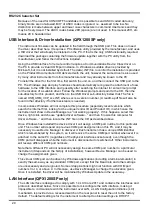
31
*OPC?
Query Operation Complete status. The response is always 1
<
RMT
>
and will be
available immediately the command is executed because all commands are
sequential.
*PRE <
NRF
>
Set the Parallel Poll Enable Register to the value <
NRF
>.
*PRE?
Returns the value in the Parallel Poll Enable Register in <
NR
1> numeric
format.
The syntax of the response is <
NR
1><
RMT
>
*SRE <
NRF
>
Sets the Service Request Enable Register to <
NRF
>
*SRE?
Report the value in the Service Request Enable Register. Response is
<
NR
1>.
*STB?
Report the value of the Status byte. Response is <
NR
1>.
*WAI
Wait for Operation Complete true. This command does nothing because all
operations are sequential.
*RST
Resets the instrument to the factory default settings
−
with the exception of
all remote interface settings. See Factory Default Settings section.
TRIPRST
Attempt to clear all trip conditions.
EER?
Query and clear the Execution Error Register. The response format is
<
NR
1><
RMT
>. See Error Reporting section for details of the response.
LSR1?
Query and clear the Limit Status Register. The response format is
<
NR
1><
RMT
>. See Status Reporting section for details of the response.
LSE1 <
NRF
>
Set the Limit Status Enable Register to <
NRF
>
LSE1?
Returns the value in the value in the Limit Status Enable register. Response
<
NR
1><
RMT
>.
QER?
Query and clear Query Error Register. The response format is nr1<
RMT
>
Interface Management Commands
LOCAL
Go to local. Any subsequent command will restore the remote state.
LOCALLOCKOUT
<
NRF
>
Sets the keyboard status where <
NRF
> has the following meaning: 1 =
keyboard locked, 0 = keyboard active.
Note that this command only affects the keyboard, not the other interfaces; if
required, use IFLOCK to disable the other interfaces.
Note: for units with main firmware prior to 4.22 this command is not
recognised and returns an error
IFLOCK
Request Instrument ‘lock’. This command requests exclusive access control of
the instrument. The response is ‘1’ is successful or ‘-1’ if the lock is un-
available either because it is already in use or the user has disabled this
interface from taking control using the web interface
IFLOCK?
Query the status of the interface ‘lock’. The return value is ‘1’ if the lock is
owned by the requesting interface instance; ‘0’ if there is no active lock or ‘-1’ if
the lock is unavailable either because it is in use by another interface or the
user has disabled the interface from taking control via the web interface.
IFUNLOCK
Release the ‘lock’ if possible. Returns ‘0’ if successful. If this command is
unsuccessful ‘-1’ is returned, 200 is placed in the Execution Error Register and
bit 4 of the Event Status Register is set indicating that you do not have the
authority to release the lock.
ADDRESS?
Returns the bus address <
NR
1><
RMT
>. This number can be used to identify
the unit




































